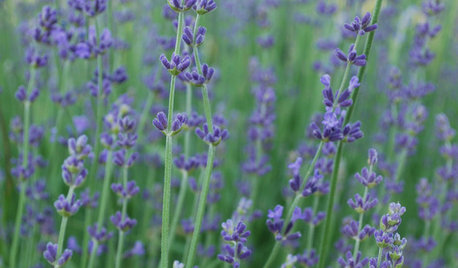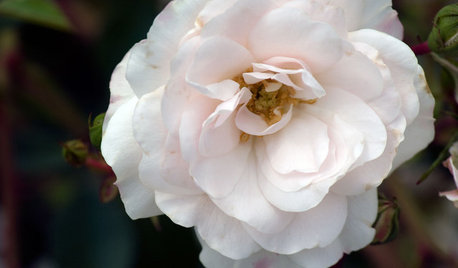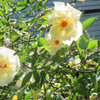The Easiest Class of Rose for you to Grow
Lynn-in-TX-Z8b- Austin Area/Hill Country
10 years ago
Featured Answer
Sort by:Oldest
Comments (68)
User
10 years agolast modified: 9 years agostrawchicago z5
10 years agolast modified: 9 years agoRelated Discussions
Easiest herbs to grow
Comments (22)Most Basil is infected with virus, which can cause sudden, inexplicable diebacks. It also does not store in the fridge nearly as well as cilantro, which seems to love the coolness. I prefer to obtain my regular cilantro supply from a local Asian food mart, since it refrigerates so well and lasts for such a short time in the garden. Like many cool weather plants, it will "bolt" (go to seed) as the weather warms up. A bit of shade can hold that off for awhile. Dill can be grown just by scattering the seed, and will come back for several years as it reseeds itself. So will fennel, although you do not want them to be close enough to pollinate each other. Like these two, cilantro is another annual that can reseed itself. If you plant tomatoes, these will all benefit from the extra watering and shade if planted near them. In fact, I heard, and have found it to be true, that planting tomatoes in a spot will improve the soil in that spot to make it easier to grow other things there at a later point. Oregano likes to be planted in the ground (or a slightly raised bed) so it has the freedom to form a low mound and spread out a bit. I have found it to be very dependable in my zone and clay soil. It will winter over in a spot with sufficient sun. Thyme and sage both have done much better for me in well-drained pots. Thyme is so small, it tends to get overshadowed and outcompeted by larger plants, and sage definitely needs the extra drainage to winter over. I have found that for some reason I apprecite fresh thyme more than any other herb, so for me it is worth growing even though the plants are so tiny. IMO it is definitely worth planting one of the larger varieties, for practical culinary use. You could also consider garlic an herb and grow that. Additionally, there are garlic and regular chives, both of which are perennial. If you have enough space for it, Egyptian onion's antics are fun to watch, and if you enjoy celery seasoning but often run out, lovage, which can grow quite tall and perennialize, is also nice to have on hand. Some mints are easier to grow than others. The basic peppermint is a pretty tough plant, but chocolate mint is more demanding. Spearmint is somewhere between the two. Pineapple mint (has white spots on leaves) will winter over for me in pots, and is great to use with the tender-but-beautiful pineapple sage in teas. There's really nothing wrong with planting mints in difficult spots no good for other plantings. It usualy doesn't spread that badly where the soil is dry and compacted, IMO; it is really only a large problem in a well cultivated, reasonably moist, bed laden with organic enrichments. Part of the fun of growing herbs is discovering your own favorites and the conditions they thrive in. It's especially nice when one you like perennializes on your property. I had lemon balm take over an entire herb garden at one point and then spread through my entire yard. After a few years, it stabilized and now I only find a few plants here and there when I want to make tea with it. Another thing that is fun with herbs is discovering that some of the cultivated and native plants--and weeds, even--that you have on your property have culinary or medicinal uses. On my land I can gather walnut, mulberry, and pokeberry leaves, elderbery blossoms, forsythia buds, rose petals, honeysuckle blossoms blueberry leaves, raspberry leaves, and all sorts of other things that can be used cautiously for various conditions. Dandilion and some other weeds are edible. Although we have an organized society that appears to be working well, it's nice to know that in hard times I could fall back on the resources offered by some of the plants I have invited to join my ecosphere....See MoreWhat is the easiest flower to grow and keep alive?
Comments (10)If one bothered to read the information posted at the top of the forum, it very clearly states that the intent of this particular forum is for the discussion of issues pertaining to the activities of professional gardeners. It is not intended to be a question and answer service for those seeking basic gardening advice - there are countless other GW forums that address those on very specific levels and much more appropriately. So why is it surprising or even considered inappropriate when a poster is directed to another site more suited to that particular inquiry? It happens all the time on other forums - maple questions on the Trees forum are directed to the Maples forum, soil questions in the Perennials forum are directed to Soils and Compost forum, etc. Basic gardening questions, and especially those from very inexperienced gardeners, are most often addressed and very thoroughly and carefully so on the New to Gardening forum. How is directing the poster to a more appropriate forum considered to be discouraging them? I'm sorry but I find it more than a little irritating when regular participants to a very specific forum are chastised by non-participants for not delving into discussions that are non-related to the topics at hand. That is the very reason there are so dang many GW forums in the first place, so they can be topic-specific and not everything to every Tom, Dick and Harry that chooses to drop in. And FWIW, master gardeners are not professional gardeners so I fail to see how that reference has any validity to the issue at hand anyway....See MoreHow many hybrid teas or other favorite class of roses do you have?
Comments (9)When I first started to grow roses, I only have my eyes on hybrid teas which I consider the perfect" rose. I think about a fourth of my 35 plus roses are hybrid teas. However, in recent years, I have been moving towards floribundas, shrubs and climbers. I guess time and taste changes, in part due to our fellow rosarians on this forum, and the desire to have more natural looking bush forms. I only buy hybrid teas if there is something I find unique about it or a chance to have it because I couldn't find it in the past. I did buy Voodoo, Chicago Peace, Strike it Rich, Double Delight and About Face this year because I finally found them after a few years searching for them. But normally I would lean towards Austins and shrubs roses....See MoreWhich rose class do you have the most of?
Comments (16)My rose list (badly) needs updating. At a guess I would say that my single biggest group are the Gallicas, possibly followed by Teas. I haven't got my ground in good enough shape for the latter to do well, but the once-blooming old roses of European origin are the best suited to our conditions, and of those the Gallicas are the largest class. So I have a lot of once-blooming old roses (Gallicas, Damasks, Albas, Centifolias, Mosses), which I love and which do well here, a lot of Teas and also Chinas, which I'm working to make the environment friendlier for, mainly lightening the soil. Quite a few ramblers, Multiflora, Wichuriana, species and hybrids, Noisettes, Lady Banks roses. A few 'Mlle. Cecile Brunner'-type old Polyanthas, a few Foetidas, and I wish I had more of both. Rugosas don't like it here, and I have my doubts about Spinosissimas; few HTs, no Floribundas, not because I reject them out of hand, but because I think conditions here aren't ready for them. Oh, I forgot: Bourbons, Hybrid Perpetuals, Hybrid Damasks. I have a few of the first, more of the second, and I like the HDs. These are heterogenous groups I don't know that much about, but there are some I like and I'm trying to figure out which ones. I have many of the Pemberton Hybrid Musks, which I love but don't grow well, and a few shrub roses, a group I don't know much about and haven't seen much of that was inspiring. Oh: practically no Austins. They're beautiful roses but it's too rough here for them....See MoreLynn-in-TX-Z8b- Austin Area/Hill Country
10 years agolast modified: 9 years agorosefolly
10 years agolast modified: 9 years agomichaelg
10 years agolast modified: 9 years agoingrid_vc so. CA zone 9
10 years agolast modified: 9 years agomad_gallica (z5 Eastern NY)
10 years agolast modified: 9 years agojaspermplants
10 years agolast modified: 9 years agojaspermplants
10 years agolast modified: 9 years agoLynn-in-TX-Z8b- Austin Area/Hill Country
10 years agolast modified: 9 years agoLynn-in-TX-Z8b- Austin Area/Hill Country
10 years agolast modified: 9 years agorosefolly
10 years agolast modified: 9 years agoLynn-in-TX-Z8b- Austin Area/Hill Country
10 years agolast modified: 9 years agomendocino_rose
10 years agolast modified: 9 years agoroseseek
10 years agolast modified: 9 years agoLynn-in-TX-Z8b- Austin Area/Hill Country
10 years agolast modified: 9 years agojaspermplants
10 years agolast modified: 9 years agoUser
10 years agolast modified: 9 years agoLynn-in-TX-Z8b- Austin Area/Hill Country
10 years agolast modified: 9 years agoUser
10 years agolast modified: 9 years agoLynn-in-TX-Z8b- Austin Area/Hill Country
10 years agolast modified: 9 years agoUser
10 years agolast modified: 9 years agoLynn-in-TX-Z8b- Austin Area/Hill Country
10 years agolast modified: 9 years agoUser
10 years agolast modified: 9 years agoLynn-in-TX-Z8b- Austin Area/Hill Country
10 years agolast modified: 9 years agoingrid_vc so. CA zone 9
10 years agolast modified: 9 years agonippstress - zone 5 Nebraska
10 years agolast modified: 9 years agoLynn-in-TX-Z8b- Austin Area/Hill Country
10 years agolast modified: 9 years agoLynn-in-TX-Z8b- Austin Area/Hill Country
10 years agolast modified: 9 years agojaspermplants
10 years agolast modified: 9 years agoingrid_vc so. CA zone 9
10 years agolast modified: 9 years agonippstress - zone 5 Nebraska
10 years agolast modified: 9 years agojerijen
10 years agolast modified: 9 years agostrawchicago z5
10 years agolast modified: 9 years agoLynn-in-TX-Z8b- Austin Area/Hill Country
10 years agolast modified: 9 years agoLynn-in-TX-Z8b- Austin Area/Hill Country
10 years agolast modified: 9 years agostrawchicago z5
10 years agolast modified: 9 years agoKippy
10 years agolast modified: 9 years agoLynn-in-TX-Z8b- Austin Area/Hill Country
10 years agolast modified: 9 years agoUser
10 years agolast modified: 9 years agostrawchicago z5
10 years agolast modified: 9 years agoLynn-in-TX-Z8b- Austin Area/Hill Country
10 years agolast modified: 9 years agostrawchicago z5
10 years agolast modified: 9 years agostrawchicago z5
10 years agolast modified: 9 years agoLynn-in-TX-Z8b- Austin Area/Hill Country
10 years agolast modified: 9 years agoLynn-in-TX-Z8b- Austin Area/Hill Country
10 years agolast modified: 9 years agostrawchicago z5
10 years agolast modified: 9 years agoLynn-in-TX-Z8b- Austin Area/Hill Country
10 years agolast modified: 9 years agostrawchicago z5
10 years agolast modified: 9 years agoLynn-in-TX-Z8b- Austin Area/Hill Country
10 years agolast modified: 9 years ago
Related Stories

GARDENING GUIDESWhat Kind of Roses Should You Grow?
Want to add the beauty of roses to your garden? Find out which ones, from old-fashioned to modern, are right for you
Full Story
GARDENING GUIDESGreat Design Plant: Grow Blueberries for Their Fruit and More
Eastern gardeners should consider growing blueberry plants for their delicious fruits, bee-friendly spring blooms and brilliant fall foliage
Full Story
SUMMER FRUITS AND VEGETABLESSummer Crops: How to Grow Beans
Grow your own beans for amazing variety and healthy, convenient produce all summer
Full Story
EDIBLE GARDENSHow to Grow Your Own Sweet Summer Crops
This guide will help any gardener get started on growing the freshest warm-season veggies and berries for summer
Full Story
GARDENING GUIDES7 New Plants to Grow for Beautiful Foliage
Add color, structure and interest to your garden with these recently introduced plants that sport exceptional foliage
Full Story
EDIBLE GARDENSHow to Grow Your Own Cocktail Garden
Conceivably, anything edible could find its way into a cocktail. Why not make the route rather short?
Full Story
FARM YOUR YARDHow to Grow Vegetables in Containers
Get glorious vegetables and fruits on your patio with a pro’s guidance — including his personal recipe for potting mix
Full Story
EARTH DAYGrow a Beautiful Garden With Ecofriendly Greywater
Reducing home water waste means lower bills and a healthier planet. Here's how to set up a greywater home irrigation system that can help
Full Story
GARDENING GUIDESYes, You Can Grow Food in a Shady Yard
Your shady garden doesn’t have to be forever barren. Berries, herbs and other shade-loving plants can produce a delicious bounty
Full Story
GARDENING GUIDES5 Favorite White Roses for a Purely Beautiful Garden
How does your garden glow? With roses that look like light and smell divine
Full Story






ingrid_vc so. CA zone 9